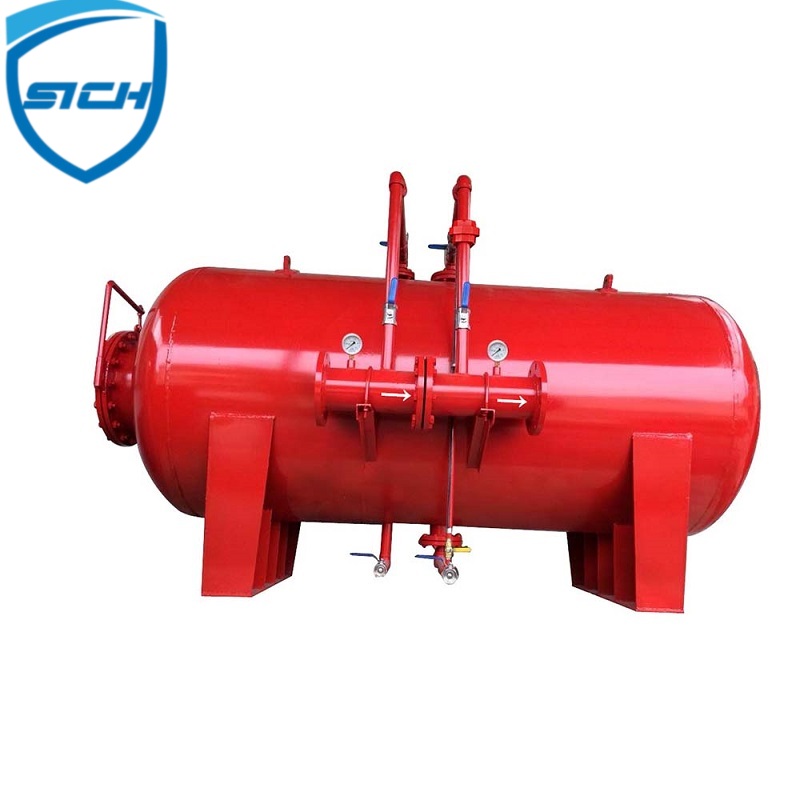Environmental factors like temperature and exposure can significantly impact the performance of horizontal bladder tanks in fire protection systems:
- Temperature Extremes: Extreme temperatures, both hot and cold, can affect the bladder material’s integrity. High temperatures might cause the bladder material to degrade, leading to potential leaks or ruptures. In contrast, extremely low temperatures can cause the bladder material to become brittle, increasing the risk of damage.
- Freezing Conditions: In colder climates, freezing temperatures can pose a risk if water remains in the tank. If water freezes within the bladder, it can cause the bladder to rupture, potentially damaging the tank and affecting its ability to hold water effectively.
- UV Exposure: Direct exposure to ultraviolet (UV) radiation from sunlight can degrade the materials used in the construction of the tank over time, leading to reduced durability and potential weakening of the bladder material.
- Chemical Exposure: Exposure to certain chemicals in the environment or adjacent substances might affect the tank’s material composition, potentially compromising its structural integrity or the bladder’s flexibility.
- Corrosive Environments: Bladder tanks located in corrosive environments, such as areas with high humidity or exposure to corrosive substances, may experience accelerated degradation of the tank material, impacting its longevity and reliability.
- Ventilation and Air Quality: Poor ventilation or exposure to pollutants in the air might affect the bladder material’s quality, potentially reducing its lifespan and overall performance.
To mitigate these environmental impacts and maintain the performance of horizontal bladder tanks, protective measures might include:
- Insulating tanks in cold climates to prevent freezing.
- Installing tanks in shaded areas or using UV-resistant materials to reduce UV exposure.
- Regular inspections to monitor for signs of degradation or damage caused by environmental factors.
- Ensuring proper ventilation and monitoring air quality in the tank’s vicinity.
Adhering to manufacturer recommendations, performing routine maintenance, and implementing protective measures can help mitigate the effects of environmental factors on the performance and longevity of horizontal bladder tanks in fire protection systems.
How do horizontal bladder tanks assist in maintaining constant water pressure in fire protection systems?
Horizontal bladder tanks play a crucial role in maintaining constant water pressure within fire protection systems by acting as a supplemental water source.
Here’s how they contribute to maintaining pressure:
- Stored Water Supply: These tanks store water under pressure, often using air or nitrogen to compress a flexible bladder within the tank. horizontal bladder tanks As the bladder compresses, it stores potential energy in the form of compressed air or gas.
- Pressure Regulation: When the fire protection system demands water due to sprinkler activation or firefighting operations, the compressed bladder forces water out of the tank, providing an immediate and steady flow of water into the system.
- Pressure Maintenance: As water is discharged from the system, the bladder inside the tank maintains the pressure by pushing the stored water into the system, ensuring a consistent water supply at the required pressure levels.
- Compensation for Demand Fluctuations: Horizontal bladder tanks compensate for fluctuations in water demand during firefighting activities. They provide an additional supply of water to meet sudden increases in demand without compromising pressure levels in the fire protection system.
- System Stabilization: These tanks help stabilize the pressure within the system, ensuring that the water supply is readily available and maintaining consistent pressure for effective operation of fire suppression equipment like sprinklers and hose lines.
- Redundancy and Reliability: Bladder tanks offer a backup water supply, providing redundancy in case the primary water supply is compromised. This redundancy enhances the reliability of the fire protection system, ensuring continuous operation during emergencies.
- Immediate Response: The immediate availability of water at a constant pressure level from the bladder tank enables rapid response to fires, allowing firefighters to access water quickly for firefighting operations.
Horizontal bladder tanks, with their ability to store pressurized water and supply it instantly when needed, serve as a critical component in fire protection systems. They ensure a consistent water supply at adequate pressure levels, supporting the efficient and effective operation of firefighting equipment in various emergency situations.
